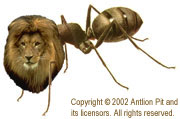The earliest antlions in literature were not the insects that we know today, but rather mythical animals that possessed qualities of both ants and lions. The history of these fictitious beasts is explored in greater detail in the section Bestiary: Creatures of Myth and Psyche. Because of the close relationship between literature and myth, the editor deems it instructive to provide a summary of one mythical "ant-lion" here.
This summary comes from El Libro de los Seres Imaginarios (The Book of Imaginary Beings), by the Argentine writer Jorge Luis Borges. He described his book as a "handbook of the strange creatures conceived through time and space by the human imagination." One of these creatures is the Mermecolion:
The Mermecolion
The Mermecolion is an inconceivable animal defined by Flaubert in this way: "lion in its foreparts, ant in its hindparts, with the organs of its sex the wrong way." The history of this monster is also strange. In the Scriptures (Job IV: 11) we read: "The old lion perisheth for lack of prey."
The Hebrew text has layish for lion; this word, an uncommon one for the lion, seems to have produced an equally uncommon translation. The Septuagint version, harking back to an Arabian lion that Aelian and Strabo call myrmex, forged the Mermecolion. After centuries, the origin of this was forgotten. Myrmex, in Greek, means ant; out of the puzzling words "The ant-lion perisheth for lack of prey" grew a fantasy (translated below by T. H. White) that medieval bestiaries succeeded in multiplying:The Physiologus said: It had the face (or fore-part) of a lion and the hinder parts of an ant. Its father eats flesh, but its mother grains. If then they engender the ant-lion, they engender a thing of two natures, such that it cannot eat flesh because of the nature of its mother, nor grains because of the nature of its father. It perishes, therefore, because it has no nutriment.


